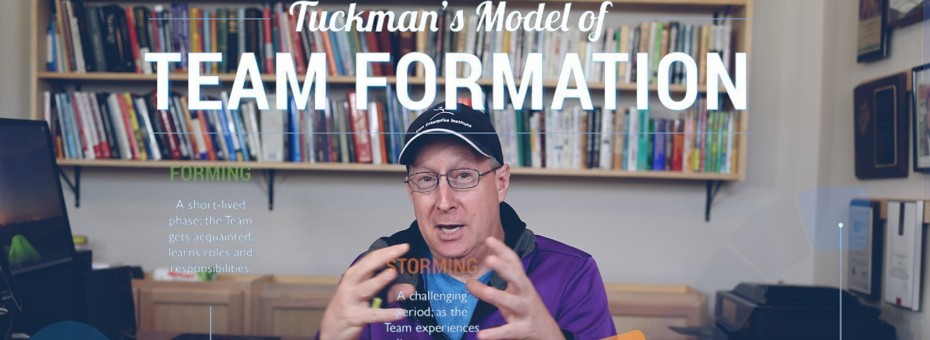Having models and systems that outline how a team operates allows for a more standardized approach to team development. By honing in on the Tuckman model, Art drives us through the rise and fall of reaching each of the four stages from the leader’s perspective. Check out a lightly edited transcript below.
Part five of eight. Watch the others:
Part one, Coaching Problem-Solving
Part two, Lessons from NBA Coaches
Part three, Lessons from Martial Arts
Part four, Military Science and Leadership
Part six, Team-Building Tools and Practices
Part seven, Dreyfus Model and the Stages of Learning
Part eight, Toyota Coaching Practices
Hi Everyone. This is Art Smalley, president of Art of Lean, Incorporated. Today, in conjunction with the Lean Enterprise Institute, I’m going to bring you another short video. This one continues our theme of problem solving and coaching, and it’s going to use some external models such as the Tuckman model, involving team development. I’m also going to share some concepts straight out of Toyota and actual Toyota guidebooks. So, stick around, I think you’ll enjoy it.
What’s the Tuckman Model?
So, many of you are probably familiar with the Tuckman model, but if not, it’s a very useful model for thinking about the stages of development. This always occurs in problem solving continuous improvement or any activity for that matter. You initially have a phase where teams come together and begin to form. There’s a little bit of a honeymoon phase, and that’s inevitably followed by a little bit of a decline, something that goes into storming because people have different ideas, concepts, agendas, personalities, behaviors, traits; a lot of things don’t gel or mesh well in the beginning. So you go into this storming phase and then the team begins to come out of that through repeated activities, discovery, learning from one another and just developing comradery and team leadership. You have a norming period where standards and roles are set, and then eventually that gets you to a higher performing state as well. It’s a little bit of a curved journey, not a linear one. I think many of you have probably heard of this model or experienced it in a team where things didn’t go well in the beginning, but eventually sorted it out and improved over the end.
Here’s another way of thinking about it. This one puts it in an X and Y-axis and shows that in a more linear format, which I don’t like, but it brings up the important point of the disconnected circles in the bottom-left hand corner. The arrows are pointing in the wrong direction. You come together, you might be happy, but you’re actually not aligned. That’s where this storming begins to occur. After the forming, you go into that storming phase and you exit storming when you start to align and have your arrows begin to point in a better direction. But in the beginning, they’re not at odds with each other. That’s why you feel like you’re storming invisibly many times as you exit that storming phase. When people achieve some type of alignment, some roles are clarified, and a direction is set. The wheel of progress continues, and things begin to get better and you evolve beyond that. You get out of the hierarchy, the rank, and the roles, and people start performing in ways that benefit, support, help one each other, a little more ego-less state where activity becomes fun and the results are better, and everyone has a good time. Ultimately, you disband in most cases.
Now, interestingly, there is a very good Toyota analogy to this. It’s the book I held up earlier. Unfortunately, this is in Japanese, and I don’t have the rights to translate it or anything like that. It’s published by the Toyota group of companies that promotes problem-solving and QC circles within the entire Toyota global group. I haven’t come across it in English yet, but it’s very similar to the Tuckman model in many respects. So I thought I would share with some concepts from it.
Unfortunately, as I said, the key point it starts with Japanese, but I will translate it into English, but it starts off with the leader’s guide. The coach’s first responsibility is to grasp the current situation regarding to the team members, their skill, their will, their interest, and motivation, and things like that. You don’t start with the Kaizen event. You don’t start with your questions. You don’t start with your pet techniques. The coaches guide, the leader’s guides, first responsibility is the grass, the current situation of the team members on the team. Let me translate this into English from Japanese.
This is an oversimplification, but you must first plot all your team members and your team and put them into zones. The zones are categorized by an X- and Y-axis. The X-axis across the horizontal bottom, the development of ability from low to high. The Y-axis is the development of will, morale, motivation, and things like that; it goes higher. In the beginning, when you’re forming, it may feel good.
New teams comes together and form, but inevitably you are going to storm and have problems. Even in Toyota, Japanese cultures, anywhere I’ve ever been around the world. The D-zone is characterized by that storming and a little bit of disjointed behavior. It can be for reasons of ability or it can be for reasons of will and morale. It’s the leader’s guide to sort the way out of this. They call it exiting the D-zone. Leveled up from there is the C-zone, where you exit that storming area and go into clearer roles and responsibilities. Phase learn methods and techniques get to work better beyond the B-zone, which is actually a very good zone. You’re now quite well-performing in many regards if you achieve the B-zone. This is because you’ve got higher levels, ability and team morale, cohesiveness, and other factors.
The upper right-hand quadrant is where the coach is trying to navigate the team to all the players on the team into that A-zone of higher levels of ability, higher levels of will and morale. If you stop and think about it, this is very similar to the Tuckman framework. The fact that you’re going through stages trying to get to a more cohesive and talented team going through an iterative process, which is not linear by any sequence or any stretch of the imagination.
Developing the X-Axis
Now, there’s no one way to guide your way through this. That’s why I’m not a big fan of just saying the answer is humble inquiry or holding a kaizen event or reading laminated cards because that’s a step-by-step process; it’s too much of a cookie cutter approach for me. I’ll summarize the contents of this book and saying that developing the team around the X and Y-axis is a lot around the skill of problem solving. We call “QC thinking,” the basics, the knowledge, the steps, and what we call the basic techniques. Secondly, you must go through multiple activities and execution learning, which is not a one-time kaizen event. It’s a multiple step journey. Third is mastering the message and getting good at obtaining results, giving presentations, developing communication skills, and working with various parties in the company. Because of that, one of the primary coaching roles in Toyota is to smooth out these situations, regarding to skill development and role rotation, within the team — it’s not just one person or one role or one team. You have to rotate people in the team over time. We’re talking about a year journey. I’m not talking about a one time, click your fingers and be done event where we check the box and say, “we’re great now.” Lastly, in the development along the X-axis is the kaizen skill. Behind every problem, there’s still another problem and a way to look at it with a more efficient manner. That’s what we’d call true kaizen, raising the standard and not just solving the currently problem. Additionally, the book talks through a lot of the coaching guide and the responsibilities of the team leader.
Developing the Y-Axis
The coach should work on the Y-axis, the will, the motivation, and the morale axis. It starts with simple things like the basic 5S rules and respect for the workplace. Just holding a kaizen event or 5S event, doesn’t do that. This is where I think if you’re going to quote martial arts and use terms, I would go all the way back to the seven virtues of a martial arts.
I would do that and think about things like integrity, respect, courage, honor, compassion, sincerity, duty, loyalty, and understanding what they mean in a team context. Some of that’s emotional; it’s not subjective. It’s not one size fits all, but you have to work on human relationships and teamwork in order to get better. People are messy. They’re not scientific experiments. Working with people is always an ongoing process and a highly rewarding one too. Third, you want to work on roles again within the team. Rotating roles and viewpoints, advancing people’s weaknesses, but also taking advantage of their strengths and interests. Fourth, another huge role of the coach, the team leader, the guide, is to work with staff subject matter experts and related departments to help or to clarify situations when they get rough or ambiguous. It’s not simple as this is not as simple as what I mistakenly hear a lot that you write an a A3 report and have a mentor. That’s an oversimplification of what occurs in Toyota. You must work with a lot of people from a lot of different areas, and you’re going to get advice. Having a coach can help you sort through that in many cases. Lastly, the coach’s responsibility is to continuously work on that motivation, the morale, and the virtue of the team members during the entire activity and outside of the activity as well. So, there’s a lot to it and I wish we had books like this for coaching and problem-solving. I think something like this would be highly useful and beneficial.
Summarizing the Zones, Models, and Stages
I just want to summarize here by saying that again, for me, coaching problem-solving goes beyond just asking open-ended questions or holding an event of some type. I think the Tuckman Model is a good one for the people in the Western world and have familiarity with it. It talks about stages of development and how different people behave and learn to work together.
The Toyota leader’s guides and the zones: the D-Zone, to the C-zone, to the B-zone, then the A-zone. That’s another good analogy. The ways you have to think along that on the X- and Y-axis, and please remember that skill and will are not the same thing. Coaching beginners, intermediates, and advanced people are not the same thing either. You have to change your coaching strategy and techniques as you go through that journey.
If nothing else, I just want you to broaden your coaching viewpoint, especially in the lean world. Think about these concepts and others because I think they’ll help you get better results faster in the end. So, I hope you enjoyed this. In the next video, we’re going to talk about one more specific technique that I think will help you a little bit during the storming phase.
Managing to Learn
An Introduction to A3 Leadership and Problem-Solving.






